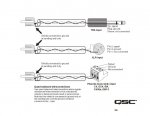I was talking to an electrician today about running an unbalanced stereo signal about 50,' and we debated the difference between shielded twisted pair and dual coaxial cables for this application.
A typical stereo RCA cable is composed of a pair of coaxial cables, typically molded together in a physically parallel configuration. In the past, I've used shielded-twisted-pair mic cable (which I have) instead of dual coax (which I don't) for unbalanced stereo signals. While dual RCA cable has separate shields for the left and right signals, a 3.5mm or 1/4" stereo connector uses the same common for them both.
Is there any reason why a shielded-twisted-pair microphone cable isn't as good for an unbalanced stereo run as a pair of individually-shielded coaxial cables?
A typical stereo RCA cable is composed of a pair of coaxial cables, typically molded together in a physically parallel configuration. In the past, I've used shielded-twisted-pair mic cable (which I have) instead of dual coax (which I don't) for unbalanced stereo signals. While dual RCA cable has separate shields for the left and right signals, a 3.5mm or 1/4" stereo connector uses the same common for them both.
Is there any reason why a shielded-twisted-pair microphone cable isn't as good for an unbalanced stereo run as a pair of individually-shielded coaxial cables?

